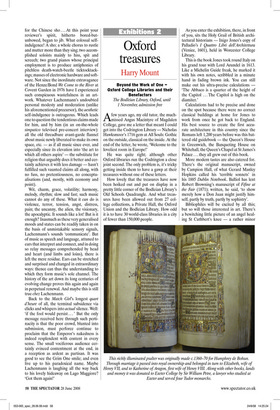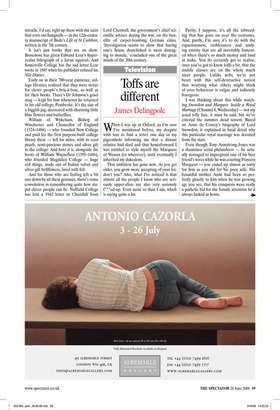Oxford treasures
Harry Mount
Beyond the Work of One — Oxford College Libraries and their Benefactors
The Bodleian Library, Oxford, until 1 November, admission free Afew years ago, my old tutor, the muchmissed Angus Macintyre of Magdalen College, gave me a letter that meant I could get into the Codrington Library — Nicholas Hawksmoor’s 1716 gem at All Souls: Gothic on the outside, classical on the inside. At the end of the letter, he wrote, ‘Welcome to the loveliest room in Europe!’ He was quite right; although other Oxford libraries run the Codrington a close joint second. The only problem is, it’s tricky getting inside them to have a gawp at their treasures without one of these letters.
How lovely that the treasures have now been hoiked out and put on display in a pretty little corner of the Bodleian Library’s Old Schools Quadrangle. And what treasures have been allowed out from 27 college collections, a Private Hall, the Oxford Union and the Bodleian Library. How odd it is to have 30 world-class libraries in a city of fewer than 150,000 people. As you enter the exhibition, there, in front of you, sits the Holy Grail of British architectural historians — Inigo Jones’s copy of Palladio’s I Quattro Libri dell’Architettura (Venice, 1601), held in Worcester College Library.
This is the book Jones took round Italy on his grand tour with Lord Arundel in 1613. Like a Michelin Guide freak, he marked it with his own notes, scribbled in a minute hand in fading brown ink. You can still make out his ultra-precise calculations — ‘The Abbaco is a quarter of the height of the Capitol ... The Capitol is high on the diamiter.’ Calculations had to be precise and done on the spot because there were no correct classical buildings at home for Jones to work from once he got back to England. His best source to create the first accurate architecture in this country since the Romans left 1,200 years before was this battered old guidebook — the Queen’s House in Greenwich, the Banqueting House on Whitehall, the Queen’s Chapel at St James’s Palace ... they all grew out of this book.
More modern tastes are also catered for. There’s the original manuscript, owned by Campion Hall, of what Gerard Manley Hopkins called his ‘terrible sonnets’ in his 1885 Dublin Notebook. Balliol has lent Robert Browning’s manuscript of Fifine at the Fair (1871); written, he said, ‘to show merely how a Don Juan might justify himself, partly by truth, partly by sophistry’.
Bibliophiles will be excited by all this; but so will those interested in art. There’s a bewitching little picture of an angel healing St Cuthbert’s knee — a rather minor miracle, I’d say, right up there with the saint that sorts out hangnails — in the 12th-century manuscript of Bede’s Life of St Cuthbert, written in the 7th century.
It isn’t just books that are on show. Brasenose has given Edward Lear’s hyperrealist lithograph of a Javan squirrel. And Somerville College has the sad letter Lear wrote in 1885 when his publisher refused his Nile Diaries.
Early on in their 700-year existence, college libraries realised that they were stores for clever people’s bric-à-brac, as well as for their books. There’s Dr Johnson’s gruel mug — kept for him whenever he returned to his old college, Pembroke. It’s the size of a biggish jug, decorated with charming little blue flowers and butterflies.
William of Wykeham, Bishop of Winchester and Chancellor of England (1324–1404) — who founded New College and paid for the first purpose-built college library there — left his mitre, with its seed pearls, semi-precious stones and silver gilt to the college. And here it is, alongside the boots of William Wayneflete (1395–1486), who founded Magdalen College — huge red things, made out of Italian velvet and silver-gilt bellflowers, lined with felt.
And for those who are feeling left a bit one down by all these geniuses, there’s some consolation in remembering quite how stupid clever people can be. Nuffield College has lent a 1942 letter to Churchill from Lord Cherwell, the government’s chief scientific adviser during the war, on the benefits of carpet-bombing German cities. ‘Investigation seems to show that having one’s house demolished is most damaging to morale,’ concluded one of the great minds of the 20th century.



















































































 Previous page
Previous page